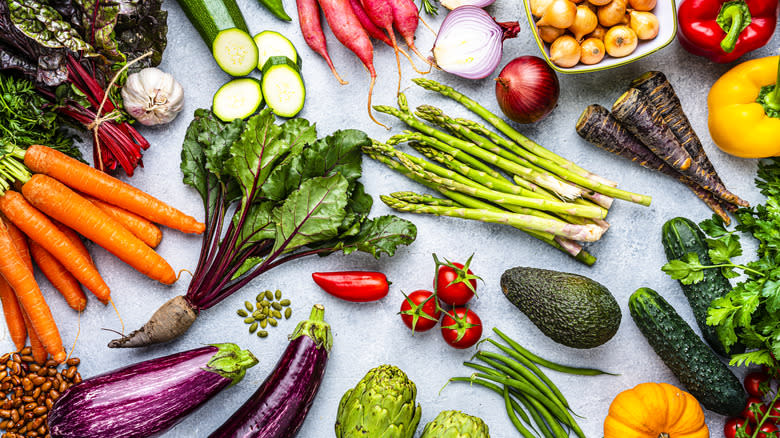You Don't Need Lettuce To Turn Your Favorite Veggies Into A Caesar Salad

Caesar salad dressing is creamy, savory, and elegantly complex, which might be why a classic Caesar salad recipe contains only lettuce and croutons. Lettuce and croutons provide a nice crunchy contrast to the hefty, creamy consistency of the dressing while letting the flavor speak for itself. However, you don't need to limit your Caesar salad to just lettuce and croutons. You can use any of your favorite vegetables in a Caesar salad with the same delicious result.
Cooked and raw vegetables will benefit from the umami-packed flavors of Caesar salad dressing. Since Caesar dressing has such a robust taste and consistency, it will stand up equally robust roasted veggies like Brussels sprouts, broccoli, and parsnips, providing a salty umami complement to their bitterness. Caesar dressing will also soften and enrich heartier leafy greens and brassicas like cabbages and kale while still complementing their crunchiness. Spiralized carrots, zucchini, and yellow squash would make great crunchy and colorful alternatives to lettuce in a Caesar salad. And you could roast green beans and asparagus with croutons as a tasty foundation for a sheet-pan Caesar salad.
You could also add raw or cooked vegetables to the typical lettuce and crouton combination to make a Caesar salad more of a main course dish. Popular renditions include mixing romaine or iceberg lettuce with kale and toasted chickpeas. Or, you could include roasted beets, slivers of red onions, and raw cherry tomatoes for a well-rounded sweet, savory, and aromatic flavor profile with an even more exciting textural contrast.
Read more: 30 Healthy Snack Ideas That Won't Ruin Your Diet
Tips For Tasty Salads

While Caesar salad dressing will taste good with just about any vegetable you add to the bowl, there are many more steps you can take to ensure that a novel Caesar salad is as delicious or more so than the original recipe. A great salad levels the balance of flavors and textures. So, if you're adding roasted or steamed vegetables that are soft and tender, pairing them with a crunchy raw vegetable or salad topper is crucial.
If you're adding raw hearty vegetables like kale, cabbage, or shaved Brussels sprouts to your Caesar salad, you can dress them and let them sit for around half an hour before adding other raw and cooked veggies. The dressing will soften them into manageable yet still slightly crunchy lettuce substitutes. Sprinkling them with salt and letting them sit is another effective method to soften them.
Another important tip to uphold the textural integrity of your salad is to add creamy and crunchy salad toppers after you've dressed the salad. Feta cheese, sliced avocadoes, beans, and croutons would become mushy or crushed by the weight of other ingredients if you tossed them in with the dressing and the rest of the ingredients. While Caesar dressing is rich and complex, you should still season your veggies with salt, pepper, and any other spices before adding the salad dressing, and often afterward, too.
Read the original article on Tasting Table.

 Yahoo Lifestyle
Yahoo Lifestyle 
